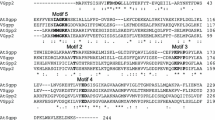Abstract
Humans afflicted by hereditary orotic aciduria are characterized by insufficiencies in the de novo pyrimidine pathway. Mutants at a nuclear gene locus in Arabidopsis, in contrast, exhibit increased activities of orotidylic acid (O5P) pyrophosphorylase (2.4.2.10) and O5P-decarboxylase (4.1.1.23). In the plants, as well as in human cells, the symptoms of the genetic disorder can be partly cured by feeding the pyrimidine analogue 6-azauracil. In normal human cells, the supply of the antimetabolite 6-azauridine leads to augmented levels of these enzymes, and in the cell cultures of patients suffering from orotic aciduria type I nearly normal levels of the enzymes are observed. In the tissues of Arabidopsis, on 6-azauracil administration, the level of O5P-pyrophosphorylase decreases while that of O5P-decarboxylase is elevated. The genetic alteration may involve a regulatory function in both humans and plants.
Similar content being viewed by others
References
Bloomfield, R. A., Letter, A. A., and Wilson, R. P. (1969). Effect of orotic acid on the lipid and acid-soluble nucleotide concentration in avian liver. Biochim. Biophys. Acta 187266.
Brown, G. K., Fox, R. M., and O'Sullivan, W. J. (1972). Alteration of quaternary structural behavior of an hepatic orotate phosphoribosyltransferase-orotidine-5′-phosphate decarboxylase complex in rats following allopurinol therapy. Biochem. Pharmacol. 212469.
Carpenter, D. C. (1952). Paper chromatography of nucleic acid derivatives. Anal. Chem. 241203.
Chung, S. C., Rédei, G. P., and White, J. A. (1974). Plastid differentiation on 6-azauracil media. Experientia 3092.
Dawson, R. M. C., Elliot, D. C., Elliot, W. H., and Jones, K. M. (1959). Data for Biochemical Research, Clarendon, Oxford.
De Deken-Grenson, M., and De Deken, R. H. (1959). Elimination of substances interfering with nucleic acids estimation. Biochim. Biophys. Acta 31195.
Fox, R. M., O'Sullivan, W. J., and Firkin, B. G. (1969). Orotic aciduria. Am. J. Med. 47332.
Girard, M. (1967). Isolation of ribonucleic acids from mammalian cells and animal viruses. Meth. Enzymol. 12A581.
Handschumacher, R. E. (1960). Orotidylic acid decarboxylase: Inhibition studies with azauridine-5-phosphate. J. Biol. Chem. 2352917.
Handschumacher, R. E., and Pasternak, C. A. (1958). Inhibition of orotidylic acid decarboxylase, a primary site of carcinostasis by 6-azauracil. Biochim. Biophys. Acta 30541.
Handschumacher, R. E., Creasey, W. A., Jaffe, J. J., Pasternak, C. A., and Hankin, L. (1960). Biochemical and nutritional studies on the induction of fatty livers by dietary orotic acid. Proc. Natl. Acad. Sci. 46178.
Holdgate, D. P., and Goodwin, T. W. (1965). Quantitative extraction and estimation of plant nucleic acids. Phytochemistry 4831.
Krooth, R. S. (1964). Properties of diploid cell strains developed from patients with an inherited abnormality of uridine biosynthesis. Cold Spring Harbor Symp. Quant. Biol. 29189.
Krooth, R. S. (1971). Molecular models for pharmacological tolerance and addiction. Ann. N. Y. Acad. Sci. 179548.
Krooth, R. S., Pan, Y.-L., and Pinsky, L. (1973). Orotidine-5′-monophosphate decarboxylase activity of crude extracts of human cells. Biochem. Genet. 8133.
Lowry, O. H., Rosebrough, N. J., Farr, A. L., and Randall, R. J. (1951). Protein measurement with the Folin phenol reagent. J. Biol. Chem. 193265.
Markham, R. (1955). Nucleic acids, their components and related compounds. In Paech, K., and Tracey, M. V. (eds.), Modern Methods of Plant Analysis, Vol. 4, Springer, Berlin, pp. 246–304.
Millikan, D. F., and Pickett, E. E. (1964). A rapid method for the extraction and identification of RNA in plant tissue. Phytochemistry 3667.
O'Donovan, G. A., and Neuhard, J. (1970). Pyrimidine metabolism in microorganisms. Bacteriol. Rev. 34278.
Pinsky, L., and Krooth, R. S. (1967a). Studies on the control of the pyrimidine biosynthesis in human diploid cells strains, I. Effect of 6-azauridine on cellular phenotype. Proc. Natl. Acad. Sci. 57925.
Pinsky, L., and Krooth, R. S. (1967b). Studies on the control of pyrimidine biosynthesis in human diploid cell strains, II. Effects of 5-azaorotic acid, barbituric acid, and pyrimidine precursors on cellular phenotype. Proc. Natl. Acad. Sci. 571267.
Rédei, G. P. (1962). Supervital mutants of Arabidopsis. Genetics 47443.
Rédei, G. P. (1963). Somatic instability caused by a cysteine sensitivity gene in Arabidopsis. Science 139767.
Rédei, G. P. (1965a). Genetic control of subcellular differentiation. In Röbbelen, G. (ed.), Arabidopsis Res. Rep. Internat. Symp., Göttingen, University of Göttingen, pp. 119–127.
Rédei, G. P. (1965b). Genetic blocks in the thiamine synthesis of the angiosperm Arabidopsis. Amer. J. Bot. 52834.
Rédei, G. P. (1967a). Suppression of a genetic variegation by 6-azapyrimidines. J. Hered. 58229.
Rédei, G. P. (1967b). Biochemical aspects of a genetically determined variegation in Arabidopsis. Genetics 56431.
Rédei, G. P. (1967c). X-ray induced phenotypic reversions in Arabidopsis. Radiat. Bot. 7401.
Rédei, G. P., Chung, S. C., and Plurad, S. B. (1973). Mutants, antimetabolites and differentiation. Brookhaven Symp. Biol. 25281–296.
Reed, L. J., and Cox, D. J. (1966). Macromolecular organization of enzyme systems. Ann. Rev. Biochem. 3557.
Smith, L. H., Jr., and Lotz, M. (1963). Studies on congenital orotic aciduria: Comparison of orotic acid metabolism in microorganisms. J. Lab. Clin. Med. 61211.
Smith, L. H., Sullivan, M., and Huguley, C. M., Jr. (1961). Pyrimidine metabolism in man. IV. Enzymatic defect of orotic aciduria. J. Clin. Invest. 40656.
Smith, L. H., Jr., Huguley, C. M., Jr., and Bain, J. A. (1972). Hereditary orotic aciduria. In Stanbury, J. B., Wyngaarden, J. B., and Fredrickson, D. S. (eds.), The Metabolic Basis of Inherited Disease, 3rd ed., McGraw-Hill, New York, pp. 1003–1029.
Wagner, R. P., Bergquist, A., Barbee, T., and Kiritani, K. (1964). Genetic blocks in the isoleucine-valine pathway of Neurospora crassa. Genetics 49865.
Wolcott, J. H., and Ross, C. (1967). Orotidine-5-phosphate decarboxylase and pyrophosphorylase of bean leaves. Plant Physiol. 42275.
Author information
Authors and Affiliations
Additional information
Contribution from the Missouri Agricultural Experiment Station. Journal Series No. 6802. Approved.
Rights and permissions
About this article
Cite this article
Chung, S.C., Rédei, G.P. An anomaly of the genetic regulation of the de novo pyrimidine pathway in the plant Arabidopsis . Biochem Genet 11, 441–453 (1974). https://doi.org/10.1007/BF00486077
Received:
Revised:
Issue Date:
DOI: https://doi.org/10.1007/BF00486077




